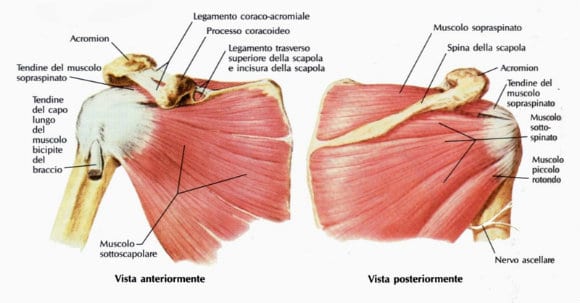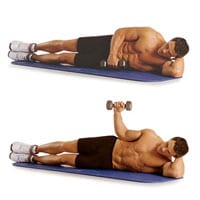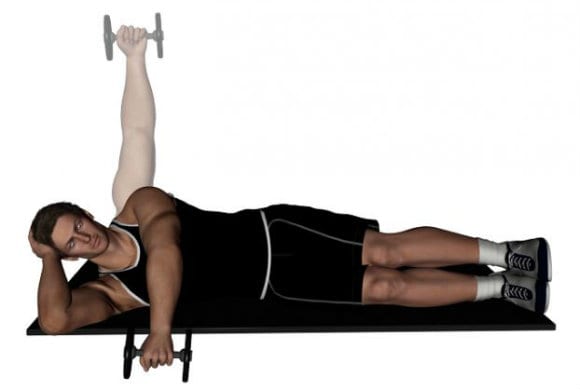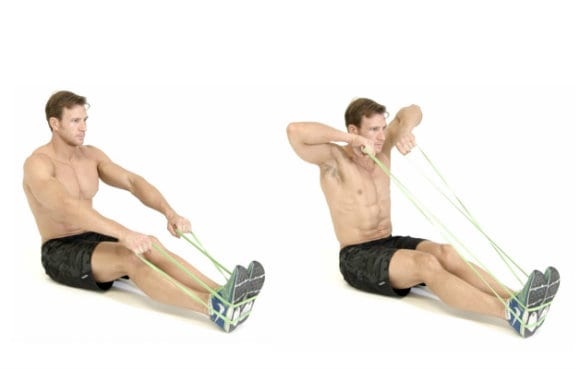By the healthiergang writer , medical student.
Rotator cuff
The term "rotator cuff" means that set of muscles and their respective tendons which contribute to the stabilization of the shoulder. These muscles are four and are respectively:
1. Infraspinatus
2. Supraspinatus
3. Subscapularis
4. Small round
The shoulder is an area where the collarbone, shoulder blade and humerus meet. There are also 5 different joints in it; it follows that this is a very mobile area and therefore particularly predisposed to injuries of various kinds.

It is important that the rotator cuff muscles are forte because its action is precisely that of avoid dislocation of the shoulder, i.e. the exit of the arm (the head of the humerus) from its seat. Equally important is the cuff tendon health: these literally envelop the head of the humerus thus protecting the joint.
Benefits
I advantages that result from a training program in which the rotator cuff muscles are also taken care of are numerous. First of all is the shoulder pain prevention: In most cases, incorrect positioning of the head of the humerus leads to squeezing some of the numerous tendons found in the shoulder. Direct consequence is the inflammation of these, this leads to assume incorrect postures and positions that with a chain mechanism compromise posture and health.
Another advantage is one greater strength and better ability to perform movements with the arm. The rotator muscles of the cuff create stability and correct positioning, this allows less energy to be dispersed during both pushing and pulling movements and therefore to lift heavier loads. In essence, the benefits are concrete and benefit the whole body.
Exercises
1. Exercises for the infraspinatus
 The infraspinatus muscle has the task of extra rotating the arm, it also stabilizes and strengthens the capsule that surrounds the humerus. Its bundles originate from a lower area on the surface of the scapula and are inserted on the upper arm (greater humeral tuberosity).
The infraspinatus muscle has the task of extra rotating the arm, it also stabilizes and strengthens the capsule that surrounds the humerus. Its bundles originate from a lower area on the surface of the scapula and are inserted on the upper arm (greater humeral tuberosity).
It is a muscle that comes frequently injured and very often it does not come never trained.
To strengthen it you can perform the following exercise: lying on your side and maintaining a 90 degree angle between the arm and the forearm, extra rotate the arm bringing the forearm from parallel to the ground to perpendicular to the ground. The goal of this exercise is to literally rotate the humerus within its seat.
It is necessary to use very light weights. If done correctly, this exercise should feel fatigued right inside the shoulder. Another variation is to perform the exercise to the cables or with some elastic bands, the important thing is that the resistance is directly opposed to the action of extra rotating the arm.
2. Exercises for the Supraspinatus
The supraspinatus muscle originates from the upper surface of the scapula and is inserted in the same area as the infraspinatus muscle. It is the shoulder muscle that is most frequently injured. Its action is to abduct (move away from the body) and extra rotate the arm.
Its work is done in synergy with the deltoid. To train it, however, you can perform the exact same exercise proposed for the infraspinatus keeping the arm raised, forming a 90 degree angle between the trunk and the arm.

Another exercise could be the face pull: fixing an elastic band at a height just above your face, grasp this at a width approximately equal to that of your shoulders. Pull the band towards your face and at the same time extra rotate your arm while contracting and lowering the shoulder blades. This is a great exercise that also allows you to train the lower trapezius.

3. Exercises for the Subscapularis
The subscapularis muscle originates from under the shoulder blade, from below, it continues with an oblique line and is inserted on the small tuberosity of the humerus. Its action is that of adduce (approach the body) and intra rotate the arm.
It generally does not require direct training as works in synergy with the bib. However, you can do one intra rotation of the arm while lying down with the back in contact with the ground and keeping the arm elevated as in the exercise for the supraspinatus muscle.
4. Exercises for the Small Round
The teres minor is a very weak and small muscle. It originates inferiorly on the scapula and inserts itself on the greater tuberosity of the humerus. Its action is to extra rotate the arm and it is synergistic to that ofinfraspinatus and then to train it you can do it same exercise.
5. Sets and Reps
The four proposed exercises can be included in your training by performing 3-4 sets of 15-20 repetitions. The benefits are guaranteed.
Good workout!


























